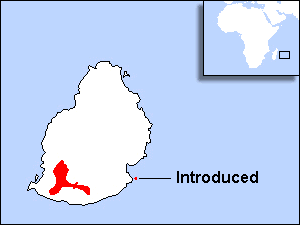
Pink Pigeon
Columba mayeri
|
Justification The population of this species has
successfully been maintained at over 50 mature individuals since 1993, but
over 250 only since 1996. It is therefore downlisted from Critical to
Endangered, but not yet to Vulnerable. However, it seems doubtful that
present populations could be maintained without the current intense
management programme and, were management to cease, this species would
stand a high risk of extinction. It still has an extremely small
population, concentrated in just a few locations, and remains threatened
by a continuing decline in the quality of suitable habitat. |
|
|
|
Threats Severe loss of habitat has been
compounded by predation of nests and adults by introduced M. fascicularis,
mongoose Herpestes auropunctatus, rats and feral cats5,8.
Cyclones destroy nests and accelerate habitat degradation4.
Disease and late-winter food shortages are also threats3.
|
|
Conservation A captive-breeding and
reintroduction programme, combined with establishment of Conservation
Management Areas, habitat restoration, control of exotic predators,
supplementary feeding, nest guarding, clutch and brood (fostering)
manipulations, rescue of eggs and young from failing nests, control of
disease and monitoring of survival and productivity, has helped this
species survive4. The |
|
Targets *Continue research into population
genetics and disease4. *Continue rehabilitation of
mainland native vegetation7. *Extend Conservation
Management Areas and surrounding predator-proof fences4.
*Consider introduction to other Mauritian islets (and Rif ecosystem
rehabilitation and predator elimination are successful7.
|
Use Your Browser's Back Button to return to the Previous Page